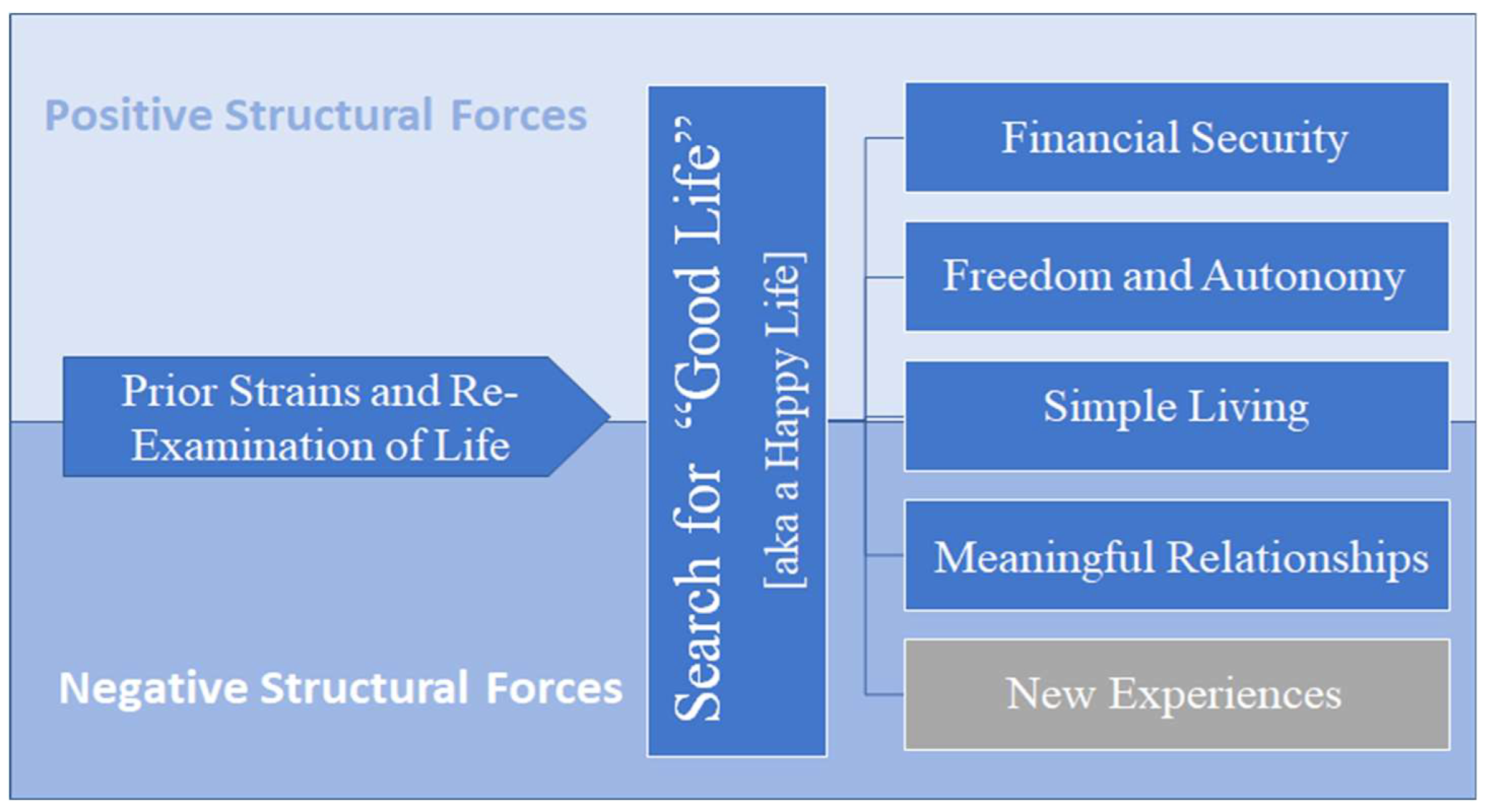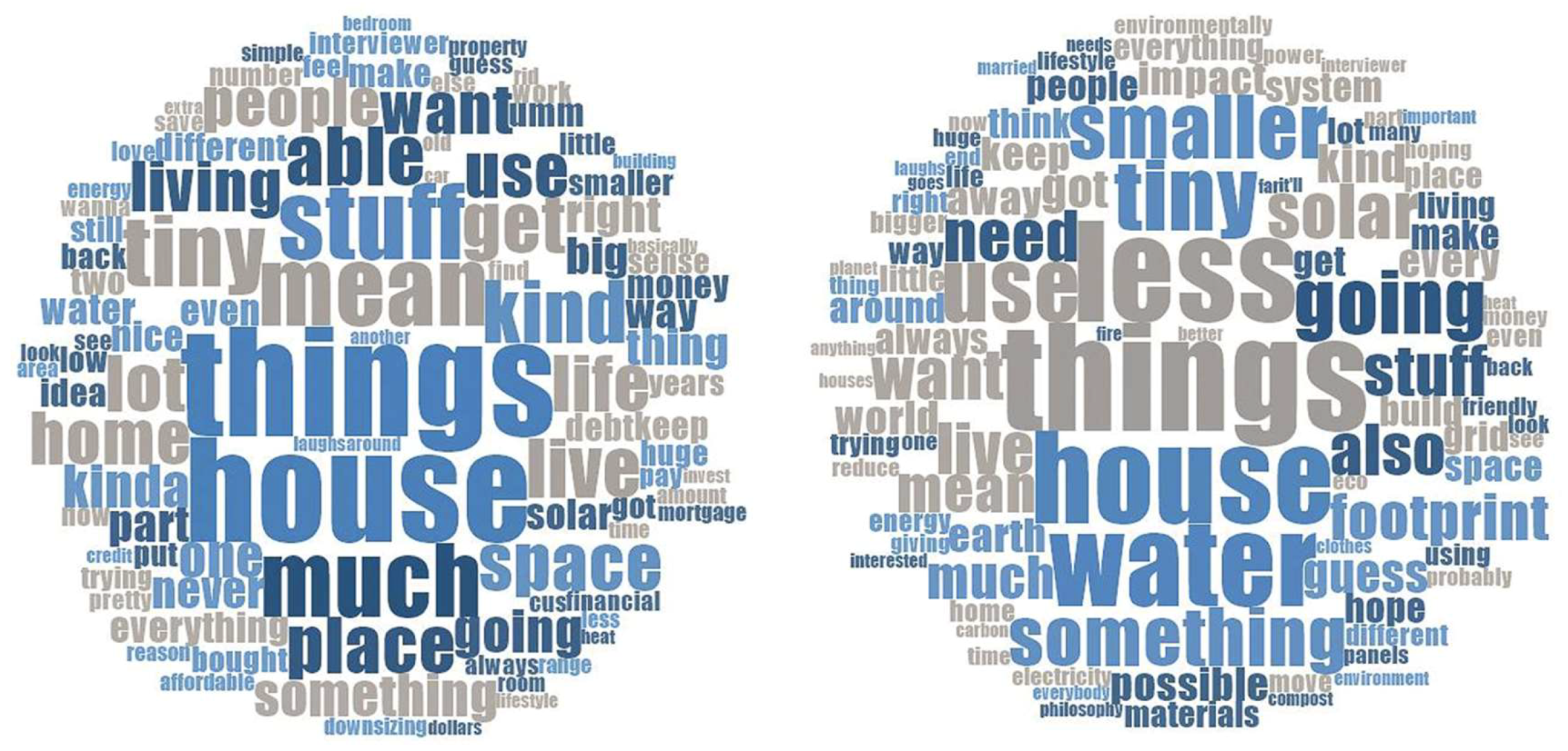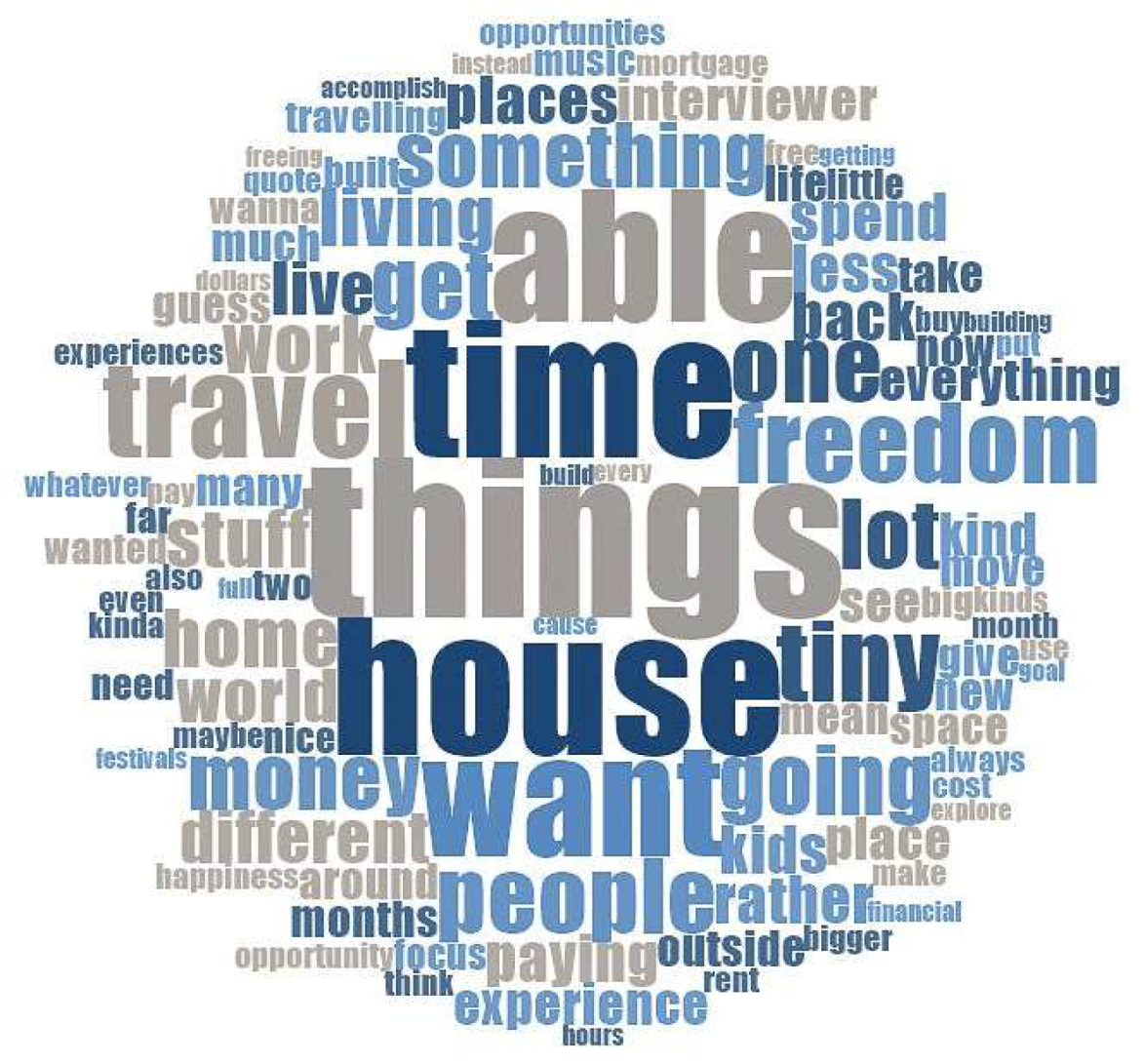In Search of the “Good Life”: The Appeal of the Tiny House Lifestyle in the USA
Abstract
:1. Introduction
2. Insights from Other Lifestyle Movements (LMS)
2.1. Voluntary Simplicity (VS) Movement
2.2. Minimalism
3. Methods
4. Results
4.1. Demographic Characteristics
4.2. Prior Strains and the Need for a Reexamination of Life
I can’t understand why I’ve spent so much money this long and why my family is doing the same thing … all under the illusion that something is being gained, but really, they just have a bunch of junk in their basement that they never look at and they’re all really unhappy with their houses.–Natalie (age 18–34)
In the wintertime we were paying to heat rooms … we never used … in the summertime, we were paying to keep them cool … sometimes I didn’t even look into … [the] rooms for … months … because it was basically storage … [I] kind of felt like this … [for] ten years and maybe back then it was like … a mid-life crisis … I was working a job working ten twelve, thirteen, fourteen hours a day … trying to maintain a home and vehicles and … never having any time … to enjoy … what I wanted to do … you get up in the morning, go to work, come home at night, eat dinner, take a shower, go to bed and … you know … that’s just how it was.–Jim (age 35–54)
Losing my house played a role. The economy collaps[ing] played a role. The fact that I have so much education and I struggle to find a job, all those things back in that time played a role in my interests in living smaller.–Ashley (age 18–34)
[H]aving my own property and not … [being] shackled down for my whole life … I feel like that’s … what really drew me to … seriously pursue this [tiny house living] … I have a serious amount of student loans and having that debt follow me around wherever I go … is very crippling … I can’t even imagine bringing on extra debt with a mortgage. My credit score’s ridiculously low and that’s why I’m having to save money.–Tessa (age 18–34)
[R]ight now we’re at a standstill of we can make it work … with our 15-year mortgage … money is super tight … we can re-finance into a 30 year, and that frees up a bunch of money, [but] … me being the nerd, I don’t want to do that.–Artemis (age 18–34)
[Divorce] it’s probably one of the key factors … [the] gal … was the love of my life … she asked for a divorce and … that was kind of a shock, I kind of dusted myself off and … said okay I really got to make a change here. So, minimalizing my lifestyle was the key ... So that’s where the whole tiny house … really came into play.–Abraham (age 55+)
4.3. Core Motivators and the Search for the “Good Life”
4.3.1. Motivator 1—Financial Security
[W]hen you look at the way that a lot of people live their lives … they’re tied to … student loans and … mortgages and all of this kind of stuff and … you work to have something to impress somebody you don’t like, for what purpose?–Rick (age 18–34)
I don’t want to pay the rent … I would rather own my own than pay … rent so … the bottom line for me is … [I want to] live a more debt free [and] responsible life.–Jane (age 55+)
I think I would be reducing, certainly I would not have a mortgage I wouldn’t … rent or if I did, maybe [at a] much reduced [cost].–John (age 55+)
[A] 30-year mortgage ties a person down … one is pretty much enslaved to one’s home … at 51 years of age, I don’t want to tie myself to a 30-year mortgage.–Larry (age 18–34)
My actual expenses yearly are a little less … than $15,000 so there’s a $35,000 savings [from my yearly income] that I’m just putting in the bank and it’s making money for me so I can do things … travel oversees … Give gifts to my family you know. It’s just a freeing experience.–Tim (age 55+)
4.3.2. Motivator 2—Freedom and Autonomy
Well, as opposed to continuing within a job I hate, making a lot of money … I got to a point where, you know I’m working sixty hours a week, I’m making a good salary, but I don’t really love it … [today] I’m no longer a slave to my job. So, I have you know twenty hours or more extra in the week to live or do things that I want to do. Instead of being stuck in Jobville forever.–Sebastian (age 35–54)
I don’t need to work 40 and 50 and 60 h a week and be able to still save and invest for you know for my future, but my monthly costs are so minimal … So yeah so some of it is freedom, but definitely economic and being part of you know being impacted by the economic downturn.–Tom (age 35–54)
If I ‘m not drowning in debt or having a whole bunch of stuff to maintain then I’m free to just live, that’s what’s attractive about that [the TH lifestyle]. I’m free to go do things, I’m free to get out there in life … and do things that I want to do.–Dan (age 35–54)
4.3.3. Motivator 3—Meaningful Relationships
I’d personally would love to get to know ‘em [other people], I’m a people person, I love talking to people and I love to hear peoples’ experiences.–Samantha (age 55+)
[S]o the experiences with each other and the growth that we’ll be able to experience as a couple hopefully because we’re so focused on each other and these experiences I think it’s going to be something that … spreads to other people around us.–Barbara (18–34)
4.3.4. Motivator 4—Simple Living
[I]f we can … live off renewable energies then essentially our bills should be nothing … so we’re hoping that we can do the earth a favor and it can do us a favor by lowering our bills.–Barbara (age 18–34)
4.3.5. Motivator 5—New Experiences
[I]t’s all about experiences and … the time that you spend with people or the time that you spend having those experiences versus the time that you are taking to manage your possessions.–Nancy (age 35–54)
[T]here are so many people that have a focus on the things that bring you happiness and I want my experiences to bring me happiness.–Barbara (age 18–34)
I’m an experience person. I have nice things, but I don’t love my things … I’d rather spend $2000 on a trip to South America than on a TV … I have a $300 TV … I’d rather take that other $1500 and spend it on an experience.–Bernie (18–34)
5. Discussion
5.1. Simple Living as Functional Pragmatism
5.2. Strive for Autonomy
5.3. Centrality of Experiences and Relationships
6. Conclusions
Author Contributions
Funding
Acknowledgments
Conflicts of Interest
References
- Adorno, Theodor W. 1975. Gesellschaftstheorie und Kulturkritik. Frankfurt: Suhrkamp. [Google Scholar]
- Ajzen, Icek. 2011. The Theory of Planned Behaviour: Reactions and Reflections. Abingdon: Taylor & Francis. [Google Scholar]
- Alexander, Samuel. 2011. The Simplicity Collective. Defining Voluntary Simplicity. Available online: http://simplicitycollective.com/defining-voluntary-simplicity (accessed on 13 February 2018).
- Alexander, Samuel. 2015. Prosperous Descent: Crisis as Opportunity in an Age of Limits. Melbourne: Simplicity Institute. [Google Scholar]
- Alexander, Samuel, and Simon Ussher. 2012. The Voluntary Simplicity Movement: A multi-national survey analysis in theoretical context. Journal of Consumer Culture 12: 66–86. [Google Scholar] [CrossRef]
- Altucher, James. 2016. How Minimalism Brought Me Freedom and Joy. Available online: https://jamesaltucher.com/2016/04/minimalism-brought-freedom-joy/ (accessed on 8 May 2018).
- Amanda. 2017. Why I Became A Minimalist. Available online: https://thetinylife.com/why-i-became-a-minimalist/ (accessed on 8 May 2018).
- Babauta, Leo. 2009. The Simple Guide to a Minimalist Life. Scotts Valley: CreateSpace. [Google Scholar]
- Bahney, Anna. 2018. Demand for Tiny Homes Is Getting Bigger. Available online: https://www.cnn.com/2018/11/02/success/tiny-homes/index.html (accessed on 15 November 2018).
- Becker, Joshua. 2015. Minimalism & The Pursuit of Happiness. Available online: https://www.becomingminimalist.com/mini-happiness/ (accessed on 30 December 2017).
- Boeckermann, Lauren M., Andrew T. Kaczynski, and Sarah B. King. 2017. Dreaming Big and Living Small: Examining Motivations and Satisfaction in Tiny House Living Senior. Columbia: University of South Carolina. [Google Scholar]
- Boujbel, Lilia, and Alain d’Astous. 2012. Voluntary simplicity and life satisfaction: Exploring the mediating role of consumption desires. Journal of Consumer Behaviour 11: 487–94. [Google Scholar] [CrossRef]
- Bryman, Alan. 2004. The Disneyization of Society. Thousand Oaks: Sage Publications. [Google Scholar]
- Bryman, Alan. 2016. Social Research Methods. Oxford: Oxford University Press. [Google Scholar]
- Buczynski, Beth. 2014. Tiny House Tell-All: What’s it Really Like to Live Small? Available online: http://www.care2.com/causes/tiny-house-tell-all-whats-it-really-like-to-live-small.html (accessed on 2 December 2017).
- Burnell, Amie. 2017. What Truly Is Minimalism? Is a Minimalist Lifestyle just for hipsters? Or is it just the Right Lifestyle to Lead You on the Road to Happiness? Available online: https://www.theodysseyonline.com/what-is-minimalism (accessed on 20 July 2018).
- Caprariello, Peter A., and Harry T. Reis. 2013. To do, to have, or to share? Valuing experiences over material possessions depends on the involvement of others. Journal of Personality and Social Psychology 104: 199. [Google Scholar] [CrossRef] [PubMed]
- Carter, Travis J., and Thomas Gilovich. 2012. I am what I do, not what I have: The differential centrality of experiential and material purchases to the self. Journal of Personality and Social Psychology 102: 1304. [Google Scholar] [CrossRef] [PubMed]
- Chaney, Matt. 2017. ‘Granny Cottages’ Are a Convenient Microliving Option for Seniors. Available online: http://www.wric.com/news/granny-cottages-are-a-convenient-micro-living-option-for-seniors/1078148083 (accessed on 14 May 2018).
- Cherrier, Hélène, and Jeff Murray. 2002. Drifting Away from Excessive Consumption: A New Social Movement based on Identity Construction. Advances in Consumer Research 29: 245–47. [Google Scholar]
- Chhetri, Prem, Asad Khan, Robert Stimson, and John Western. 2009. Why bother to ‘downshift’? The characteristics and satisfaction of downshifters in the Brisbane-South East Queensland region, Australia. Journal of Population Research 26: 51–72. [Google Scholar] [CrossRef]
- Craig-Lees, Margaret, and Constance Hill. 2002. Understanding Voluntary Simplifiers. Psychology & Marketing 19: 187–210. [Google Scholar]
- Elgin, Duane. 2006. Voluntary Simplicity and the New Global Challenge. In The Environment in Anthropology: A Reader in Ecology, Culture, and Sustainable Living. New York: NYU Press, pp. 458–68. [Google Scholar]
- Elgin, Duane, and Arnold Mitchell. 1977. Voluntary Simplicity. In Co-Evolution Quarterly. Sausalito: Co-Evolution Quarterly. [Google Scholar]
- Etzioni, Amitai. 1998. Voluntary simplicity: Characterization, select psychological implications, and societal consequences. Journal of Economic Psychology 19: 619–43. [Google Scholar]
- Fagan, Chelsea. 2017. Minimalism: Another Boring Product Wealthy People Can Buy. Available online: https://www.theguardian.com/lifeandstyle/2017/mar/04/minimalism-conspicuous-consumption-class (accessed on 3 December 2017).
- Fishbein, Martin, and Icek Ajzen. 1975. Belief, Attitude, Intention and Behavior: An Introduction to Theory and Research. Reading: Addison-Wesley. [Google Scholar]
- Fogg, Brian J. 2009. A behavior model for persuasive design. Paper presented at 4th International Conference on Persuasive Technology, Claremont, CA, USA, April 26–29. [Google Scholar]
- Ford, Jasmine, and Lilia Gomez-Lanier. 2017. Are Tiny Homes Here to Stay? A Review of Literature on the Tiny House Movement. Family and Consumer Sciences Research Journal 45: 394–405. [Google Scholar] [CrossRef]
- Friedlander, David. 2014. Talking to Jay Shafer about Making the Universal House. Available online: http://lifeedited.com/jay-shafer-four-lights-future-of-tiny-houses/ (accessed on 22 October 2016).
- Fromm, Erich. 1941. Escape from Freedom. New York: Rinehart and Winston. [Google Scholar]
- Gardner, Brain. 2015. Why Minimalism Is a Better Way of Life. Retrieved 5–15, 2018. Available online: https://nosidebar.com/why-minimalism/ (accessed on 15 May 2018).
- Gilovich, Thomas, Amit Kumar, and Lily Jampol. 2015. A wonderful life: Experiential consumption and the pursuit of happiness. Journal of Consumer Psychology 25: 152–65. [Google Scholar] [CrossRef]
- Gregg, Richard B. 2009. The Value of Voluntary Simplicity. Portland: The Floating Press. First published 1936. [Google Scholar]
- Grigsby, Mary. 2004. Buying Time and Getting by: The Voluntary Simplicity Movement. Albany: SUNY Press. [Google Scholar]
- Haenfler, Ross, Brett Johnson, and Ellis Jones. 2012. Lifestyle movements: Exploring the intersection of lifestyle and social movements. Social Movement Studies 11: 1–20. [Google Scholar] [CrossRef]
- Hanks, Bethany. 2017. 7 Reasons why People Live in Tiny Houses. Available online: https://www.deseretnews.com/article/865681921/7-reasons-why-people-live-in-tiny-houses.html (accessed on 2 December 2017).
- Heather. 2017. Tiny House Living and Transcendentalism. Available online: http://harperacademyushistoryandlit.blogspot.com/2017/10/tiny-house-living-and-transcendentalism.html (accessed on 20 July 2018).
- Howell, Ryan T., and Graham Hill. 2009. The mediators of experiential purchases: Determining the impact of psychological needs satisfaction and social comparison. The Journal of Positive Psychology 4: 511–22. [Google Scholar] [CrossRef]
- Jennifer. 2015. How I Became a Minimalist (Why I Choose to Live with Less). Available online: http://www.simplyfiercely.com/how-i-became-a-minimalist/ (accessed on 21 July 2018).
- Jones, Charisse. 2016. Recession-scarred Millennials helping fuel tiny house trend. USA Today, May 18. [Google Scholar]
- Jordan, Jones. 2017. Why You Should Live Tiny: An Interview with Gabriella and Andrew Morrison of Tiny House Build. Available online: https://www.huffpost.com/entry/mindfulness-practice_b_5613549 (accessed on 6 December 2017).
- Kamal, Jenna. 2017. Tiny Homes and Trending Minimalism. Liverpool: Property Moose. [Google Scholar]
- Kennedy, Emily Huddart, Harvey Krahn, and Naomi T. Krogman. 2013. Downshifting: An Exploration of Motivations, Quality of Life, and Environmental Practices. Sociological Forum 28: 764–83. [Google Scholar] [CrossRef]
- Kilman, Charlie. 2016. Small House, Big Impact: The Effect of Tiny Houses on Community and Environment. Available online: https://pdfs.semanticscholar.org/2732/8c4ba21b4f6ae467210ddffd3edb2da8fa4b.pdf (accessed on 17 January 2019).
- Kronenburg, Robert. 2017. Tiny Homes May Hold Some Answers for the Housing Crisis. Available online: http://www.businessinsider.com/tiny-houses-housing-crisis-2017-5 (accessed on 2 December 2017).
- Lasky, Julie. 2016. The Surprising Origins of the Tiny House Phenomenon: Why Ancient Hermits Are the Key to Understanding Our Tiny Home Obsession. Available online: http://www.curbed.com/2016/7/13/12162832/tiny-house-history-hermits (accessed on 21 October 2016).
- Leonard-Barton, Dorothy. 1981. Voluntary simplicity lifestyles and energy conservation. Journal of Consumer Research 8: 243–52. [Google Scholar] [CrossRef]
- Levin, Heather. 2012. Living in a Tiny Home: Benefits & Drawbacks. Available online: https://abcnews.go.com/Business/living-tiny-home-benefits-drawbacks/story?id=17742823 (accessed on 2 December 2017).
- Lewis, Paul. 2017. Tiny Houses: Salvation for the Homeless or a Dead End? Available online: https://www.theguardian.com/us-news/2017/mar/23/tiny-houses-solution-homelessness-seattle (accessed on 2 December 2017).
- McDonald, Seonaidh, Caroline J. Oates, C. William Young, and Kumju Hwang. 2006. Toward sustainable consumption: Researching voluntary simplifiers. Psychology & Marketing 23: 515–34. [Google Scholar]
- McMahon, Darrin M. 2006. Happiness: A History. New York: Grove Press. [Google Scholar]
- Millburn, Joshua Fields, and Ryan Nicodemus. 2015. Minimalism: Live a Meaningful Life. Montana: Asymmetrical Press. [Google Scholar]
- Mitchell, Ryan. 2014. Tiny House Living: Ideas for Building and Living Well in Less than 400 Square Feet. Newton Abbot: Betterway Home Books. [Google Scholar]
- Mitchell, Terence R., Leigh Thompson, Erika Peterson, and Randy Cronk. 1997. Temporal adjustments in the evaluation of events: The “rosy view”. Journal of Experimental Social Psychology 33: 421–48. [Google Scholar] [CrossRef] [PubMed]
- Mutter, Amelia. 2013. Growing Tiny Houses Motivations and Opportunities for Expansion Through Niche Markets. Lund: LUND University. [Google Scholar]
- Nathan, Rob. 2014. Life in a Tiny House. Available online: https://www.nwei.org/life-tiny-house/ (accessed on 8 May 2018).
- Nelson, Alyse. 2012. Living Large in Small Houses. Available online: http://grist.org/living/living-large-in-small-houses/ (accessed on 2 December 2017).
- Nelson, Michelle R., Mark A. Rademacher, and Hye-Jin Paek. 2007. Downshifting Consumer = Upshifting Citizen? An Examination of a Local Freecycle Community. The Annals of the American Academy of Political and Social Science 611: 141–56. [Google Scholar] [CrossRef]
- Nicolao, Leonardo, Julie R. Irwin, and Joseph K. Goodman. 2009. Happiness for sale: Do experiential purchases make consumers happier than material purchases? Journal of Consumer Research 36: 188–98. [Google Scholar] [CrossRef]
- Pine, B. Joseph, II, and James H. Gilmore. 1999. The Experience Economy. Boston: Harvard Business School Press, pp. 35–38. [Google Scholar]
- Reggev, Kate. 2017. How Tiny and Prefab Homes Can Help People Recover After Natural Disasters. Available online: https://www.dwell.com/article/how-tiny-and-prefab-homes-can-help-people-recover-after-natural-disasters-1e77e19a (accessed on 1 January 2018).
- Ritzer, George. 2005. Enchanting a Disenchanted World: Revolutionizing the Means of Consumption, 2nd ed. Thousand Oaks: Pine Forge Press. First published 1999. [Google Scholar]
- Rodriguez, Jason. 2017. The US Minimalist Movement: Radical Political Practice? Review of Radical Political Economics. [Google Scholar] [CrossRef]
- Ross, Spencer M. 2015. Whither Simplicity? An Exploratory Study of The Antecedents of Voluntary Simplicity. In Marketing Dynamism & Sustainability: Things Change, Things Stay the Same…. Berlin: Springer, pp. 20–29. [Google Scholar]
- Rowe, Christopher J., and Sarah Broadie. 2002. Nicomachean Ethics. Oxford: Oxford University Press. [Google Scholar]
- Russell, Melissa. 2017. What Is Minimalism? Plus 8 Things It’s NOT. Available online: https://simplelionheartlife.com/what-is-minimalism/ (accessed on 1 January 2018).
- Schor, Juliet B. 1999. The Overspent American: Why We Want What We Don’t Need. New York: HarperPerennial. [Google Scholar]
- Schulze, G. 2005. Die Erlebnisgesellschaft: Kultursoziologie der Gegenwart. Frankfurt: Campus Verlag. First published 1994. [Google Scholar]
- Shama, Avraham, and Joseph Wisenblit. 1984. Values of voluntary simplicity: Lifestyle and motivation. Psychological Reports 55: 231–40. [Google Scholar] [CrossRef]
- Shearer, Heather, and Paul Burton. 2018. Towards a Typology of Tiny Houses. Housing, Theory and Society, 1–21. [Google Scholar] [CrossRef]
- Shi, David E. 1985. The Simple Life: Plain Living and High Thinking in American Culture. New York: Oxford University Press. [Google Scholar]
- Skidelsky, Edward, and Robert Skidelsky. 2012. How Much Is Enough? Money and the Good Life. New York: Other Press LLC. [Google Scholar]
- Smelser, Neil J. 2011. Theory of Collective Behavior. New Orleans: Quid Pro Books. [Google Scholar]
- Sundbo, Jon. 2009. Innovation in the experience economy: A taxonomy of innovation organizations. The Service Industries Journal 29: 431–55. [Google Scholar] [CrossRef]
- Sundbo, Jon, and Per Darmer. 2008. Creating Experiences in the Experience Economy. Cheltenham: Edward Elgar Publishing. [Google Scholar]
- Susanka, Sarah, and Kira Obolensky. 1998. The Not So Big House: A Blueprint for the Way We Really Live. Newtown: Taunton Press. [Google Scholar]
- Thoreau, Henry David. 1910. Walden. New York: Thomas Y. Crowell & Co. [Google Scholar]
- Van Boven, Leaf, and Thomas Gilovich. 2003. To do or to have? That is the question. Journal of Personality and Social Psychology 85: 1193. [Google Scholar] [CrossRef] [PubMed]
- Walker, Lester. 1987. Tiny Tiny Houses or How to Get Away from It All. New York: Overlook Press. [Google Scholar]
- Weinstein, Netta, Andrew K. Przybylski, and Richard M. Ryan. 2012. The index of autonomous functioning: Development of a scale of human autonomy. Journal of Research in Personality 46: 397–413. [Google Scholar] [CrossRef]
- Williams, Robin Murphy. 1970. American Society: A Sociological Interpretation. New York: Knopf. [Google Scholar]
- Wright, Colin. 2010. Minimalism Explained. Exile Lifestyle, September 15. [Google Scholar]
| 1 | Tiny house enthusiasts usually make a distinction between small and tiny houses. True tiny houses, in this view, are dwellings (whether on foundation or wheels) smaller than 400 sqft. Small houses, by contrast, usually range from 400 sqft to 1000 sqft. |
| 2 | Our views on the Good Life have been strongly influenced by Skidelsky and Skidelsky’s 2012 treatise “How Much is Enough? Money and the Good Life”. New York, Other Press LLC. The authors define the Good Life as “a life that is desirable, or worthy of desire”. While specific conceptions have varied across time and space, Skidelsky and Skidelsky (2012) maintain that there is broad philosophical agreement on what constitutes the “basic goods [or elements]” of the Good Life (i.e., health, respect, security, relationships of trust and love). Building on Amartya Sen’s theoretical work on human capabilities (e.g., “the capacity to be healthy”), the authors argue that these universal “basic goods … are not just means to, or capabilities for a good life; they are the good life.” |
| 3 | Rodriguez (2017, p. 1) views minimalism as “a broad array of practices that have been labeled differently at different historical moments”. By broadening the term, however, he inflates much of the work on the “voluntary simplicity movement” that documents its unique character. Cherrier and Murray (2002) contend that minimalism and voluntary simplicity are distinct movements that may share some of the same grievances but offer two very different anti-consumerist pathways. |
| 4 | Information on the interviewee’s race, religious affiliation, education level, household income, and political orientation was collected. Rather than using a premade survey item for political orientation, we allowed the participants to self-identify (and coded their responses into a broad conservative, liberal, libertarian, and “other” category). We thought that this information could prove useful in providing further insights as to whether “ideological leanings” create particular affinities to tiny living. This relationship proved to be difficult to disentangle empirically. |
| 5 | To establish the primacy of choice for each individual (and hence assign interviewees to one of the three categories), we considered three key indicators: (1) How early in the interview someone talks about environmental reasons (e.g., first response to the question or later in the interview), (2) the amount of time someone spent talking about personal as opposed to environmental considerations, and (3) the primary reason given for a particular choice (e.g., personal benefits versus benefits for the environment, community, society or others). |
| 6 | The authors assume full responsibility for any problems with the quality of the English translation of Schulze’s German original. |






| Pseudonym | Age | Gender | Race | Political Orientation | Household Income | Education | Religion | TH Status |
|---|---|---|---|---|---|---|---|---|
| Artemis | 18–34 | female | white | conservative | $50,000––$74,999 | college degree | Christian | building stage |
| Frank | 18–34 | male | white | liberal | less than $25,000 | college degree | Agnostic | living in TH |
| Namor | 18–34 | male | white | other | $50,000–$74,999 | post-graduate degree | Christian | living in TH |
| Barbara | 18–34 | female | white | other | $25,000–$34,999 | college degree | Atheist | planning stage |
| Tessa | 18–34 | female | other | other | $25,000–$34,999 | college degree | Agnostic | planning stage |
| Ashley | 18–34 | female | white | conservative | $25,000–$34,999 | college degree | Christian | planning stage |
| Rick | 18–34 | male | white | conservative | $75,000–$99,999 | some post-graduate work | Christian | planning stage |
| Luna | 18–34 | female | white | liberal | $75,000–$99,999 | college degree | Atheist | planning stage |
| Natalie | 18–34 | female | white | liberal | $25,000–$34,999 | some college | Atheist | planning stage |
| Bernie | 18–34 | male | white | libertarian | $100,000–$149,999 | some college | Other | planning stage |
| Tom | 35–54 | male | white | other | $75,000–$99,999 | post-graduate degree | Spiritual | living in TH |
| Ben | 35–54 | male | white | liberal | $50,000–$74,999 | post-graduate degree | Agnostic | living in TH |
| Larry | 35–54 | male | other | other | $50,000–$74,999 | less than high school | Spiritual | building stage |
| Greta | 35–54 | female | Asian | liberal | $50,000–$74,999 | college degree | Agnostic | planning stage |
| Jenny | 35–54 | female | white | libertarian | $35,000–$49,999 | trade/technical/vocational training | Christian | planning stage |
| Nancy | 35–54 | female | white | other | $50,000–$74,999 | college degree | Christian | living in TH |
| Sebastian | 35–54 | male | white | liberal | $25,000–$34,999 | post-graduate degree | Other | living in TH |
| Dan | 35–54 | male | white | conservative | $35,000–$49,999 | some post-graduate work | Other | building stage |
| Brittany | 35–54 | female | black | liberal | $50,000–$74,999 | post-graduate degree | Christian | planning stage |
| Jim | 35–54 | male | white | liberal | $50,000–$74,999 | high school | Spiritual | living in TH |
| Jane | 55+ | female | white | other | $25,000–$34,999 | college degree | Spiritual | planning stage |
| Mary | 55+ | female | white | liberal | $75,000–$99,999 | college degree | Christian | planning stage |
| John | 55+ | male | white | other | $25,000–$34,999 | post-graduate degree | Spiritual | planning stage |
| Tim | 55+ | male | white | liberal | $50,000–$74,999 | post-graduate degree | Spiritual | living in TH |
| Canan | 55+ | male | white | liberal | $75,000–$99,999 | some college | Other | living in TH |
| Venus | 55+ | female | white | other | less than $25,000 | post-graduate degree | Buddhist | planning stage |
| Morgan | 55+ | female | other | other | less than $25,000 | some post-graduate work | Spiritual | living in TH |
| Samantha | 55+ | female | white | other | $35,000–$49,999 | some college | Christian | building stage |
| Shirley | 55+ | female | white | conservative | $35,000–$49,999 | post-graduate degree | Christian | planning stage |
| Abraham | 55+ | male | white | other | $35,000–$49,999 | high school | Christian | planning stage |
© 2019 by the authors. Licensee MDPI, Basel, Switzerland. This article is an open access article distributed under the terms and conditions of the Creative Commons Attribution (CC BY) license (http://creativecommons.org/licenses/by/4.0/).
Share and Cite
Mangold, S.; Zschau, T. In Search of the “Good Life”: The Appeal of the Tiny House Lifestyle in the USA. Soc. Sci. 2019, 8, 26. https://doi.org/10.3390/socsci8010026
Mangold S, Zschau T. In Search of the “Good Life”: The Appeal of the Tiny House Lifestyle in the USA. Social Sciences. 2019; 8(1):26. https://doi.org/10.3390/socsci8010026
Chicago/Turabian StyleMangold, Severin, and Toralf Zschau. 2019. "In Search of the “Good Life”: The Appeal of the Tiny House Lifestyle in the USA" Social Sciences 8, no. 1: 26. https://doi.org/10.3390/socsci8010026
APA StyleMangold, S., & Zschau, T. (2019). In Search of the “Good Life”: The Appeal of the Tiny House Lifestyle in the USA. Social Sciences, 8(1), 26. https://doi.org/10.3390/socsci8010026






